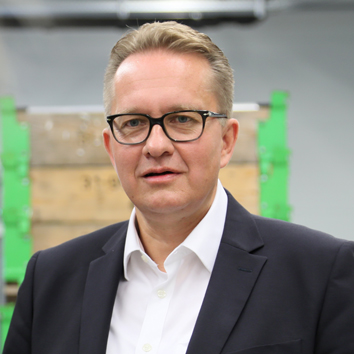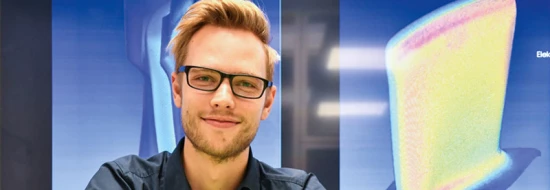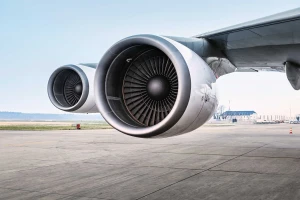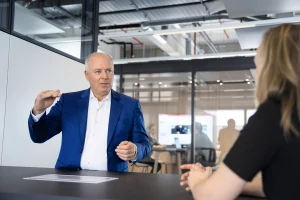people
The engine maker’s supply chain
Interview with Uwe Böhm, Head of Purchasing at MTU Aero Engines, on the supplier base for the engine industry and its special features.
11.2019 | author: Eleonore Fähling | 5 mins reading time
author:
Eleonore Fähling
has been on the AEROREPORT editorial team since 2014 and in charge of the MTU employee magazine since 1999. As an aerospace journalist, she specializes in aviation history and market topics.

Mr. Böhm, how many suppliers work for MTU worldwide? And where are they based?
We work with about 500 companies that supply production materials for our engine components. When it comes to individual components, the number of suppliers we use varies greatly. In some cases, only very few specialists worldwide are able to supply the parts we need to the standard of quality required in the aviation industry. Of course, there are more suppliers for the less sophisticated components, such as basic standard parts. We work with companies across the world, primarily in North America, Europe and the Middle East, but also in Mexico and Asia.
What kinds of companies are they?
They range from highly specialized, family-owned medium-sized companies with an annual turnover of a few million euros to groups that are considerably bigger than MTU. Many specialist engine suppliers have based themselves in close proximity to the OEMs GE Aviation and Pratt & Whitney, which explains why many of the companies we work with are in the U.S. and indeed on the East Coast. You find the whole spectrum of suppliers there, from inventors who simply buy some land and set up a finishing workshop to highly specialized corporate groups.
How many suppliers for specific product groups are there worldwide?
There are actually very few in the engine industry. This is due to the high complexity of our components and above all to the strict safety requirements in aviation.
What does a supplier to the aviation industry have to be able to do?
For a start, it has to have been awarded all the licenses required in the aviation sector. Getting them can take up to two years. And whenever an aviation company expands its capacities, then any new facilities must first be licensed before components destined for use in the aviation industry can be manufactured there. That’s what makes it difficult to simply increase the production rate. Aviation suppliers also have to guarantee extremely high quality standards and undergo regular inspections. One particularly important aspect is their ability and willingness to continuously invest in technology developments. Our suppliers know that they have to constantly develop at this high level. And last, but not least, our suppliers have to be able to produce at a competitive cost.
How do you ensure that suppliers deliver to the right quality on a long-term basis?
“Quality first” is our top priority. We always work closely in interdisciplinary teams with the relevant departments to select appropriate suppliers. We conduct audits on site and have permanent representatives at key suppliers in the U.S. and Asia. But, most of all, we work together as partners on an equal footing – maybe that’s what’s special about MTU. And this has proven beneficial over the years.
When the launch of the A400M military transport was pushed back, several smaller suppliers faced financial difficulty, meaning that Airbus had to save them. Is that something that MTU would consider doing?
Of course we would consider it, but in fact our active supplier risk management prevents such situations from developing in the first place – and so far, it’s always been a great success.
What happens when a supplier can no longer deliver?
In that case, we send out a crisis intervention team to work with the supplier to analyze the causes and find solutions. Like I said before: we prefer to work as partners on an equal footing and in the common interest. When it comes to critical components, we don’t rely on just a single supplier; rather, we usually have two sources or more.
The aviation market – and, with it, demand for aircraft – has been continuously growing for 20 years. Until now, the aviation industry has always gradually adjusted its capacities in line with that growth. Is that still enough?
In all of aviation history, there’s never been a ramp-up like the one we’re seeing at present. You’re right, we won’t be able to keep pace just by optimizing current capacities. The entire aviation industry supply chain has to make huge investments to cope with this expansion. Another key to our success is our integrated product development teams, in which our suppliers work hand in hand with MTU’s developers and design engineers to improve the manufacturability of components.
Surely suppliers to aircraft manufacturers, including engine manufacturers, will be delighted if Airbus steps up deliveries of the A320 to 70 aircraft per month. Where’s the problem?
Our supplier base’s capacity situation is extremely strained, especially when it comes to high-tech components like monocrystalline turbine blades. All manufacturers go to the same few suppliers for these. Delivery times for certain forged parts have almost doubled in the past few years. For many of our deliveries, we have a procurement time of more than a year. This means there isn’t a lot of scope for short-term changes. Naturally, we also have concepts such as consignment warehouses at suppliers in order to increase flexibility. These are warehouses that store finished components until we retrieve them. This gives us some breathing space. In addition, stable predictions of the amounts needed in the next few years help to prevent bottlenecks in the future.
On top of that, we and our suppliers now also need to take the next step technologically, as geared turbofan engine components, for example for the high-speed low-pressure turbines, are considerably more complex than those for older engines such as the V2500. The production ramp-up for them wasn’t nearly as steep as now.
Over the new few years, MTU will invest around one billion euros in the expansion of existing and new locations. Is insourcing the answer?
This isn’t about insourcing at all, but about MTU’s organic growth. The mix of in-house and external production is determined beforehand in a common manufacturing strategy and is incorporated into location planning.









